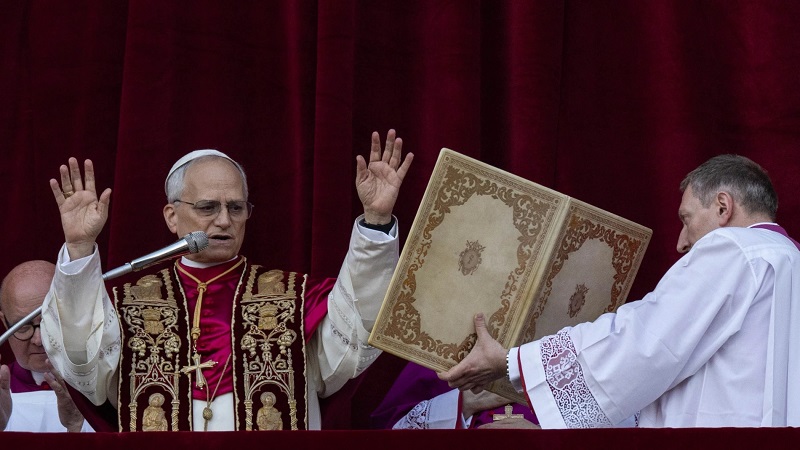
Symphony turned into political text, Luis Bonaparte’s Brumario He sentenced that the memory of dead generations harassed the brain of the living. Converted into History weightthe past sprouted in the present, turning words, speeches and actors. Karl Marx I reviewed that Transition periodin the mid -nineteenth century, which Alain Brossat defined as “the no more of the bourgeois revolution, not yet of the proletarian revolution.” Uncertain time, of unfinished and failed revolutionary uprisings; of definitive passage of the capitalist class to the field of social and political conservatism.
Ontologically conservative, The Catholic Church It makes this memory of dead generations resonate at every moment. Robert PrevostNew Pope, marched a century and a half ago to choose his name. Giving traditions, Leo XIV rescued the tradition of Leo XIIIthat so -called “labor potato”, author of the encyclical Of the revolutionary (Of the new things) and a putative father of the Vatican social doctrine.
Published in 1891, Of the revolutionary It is, since its inception, both a Criticism of the evils that engenders social inequality Like one explicit condemnation of the ideas of socialism and revolution. Call for “social peace”, it summons to reject “that fantasy of socialism of reducing private property to common, because it damages those who are intended to help, disgust to the natural rights of individuals and disturbs the functions of the State and common tranquility (…) When the problem of improving the condition of the lower classes is posed, the principle that private property has to be kept inviolable has to be kept.
Converting private property in part of a natural order Created by God, the encyclical offers the Church as a mediation of that social peace that guarantees the capital its domination. Warning the dangers of “the greatest confidence of the workers themselves and the closest cohesion between them”, the text also prays that “neither capital can subsist without work, nor work without capital (…) to end the struggle and cut to the same roots, it is admirable and varies the strength of Christian doctrines (…) All the doctrine of the Christian religion, of which it is an interpreter and custodian The Church can greatly fix with each other and unite the rich with the proletarians, that is, calling both classes to fulfill their respective duties and, above all, to the duties of justice. ”
The Encyclical saw the light in May 1891two decades after that huge revolutionary deed that, taking the name of Commune of Paris, moved Europe. It coincided over time with the organizational and political ascent of the working class, four years later, in a famous and discussed introduction, Federico Engels celebrated the political and electoral strengthening of the working class and its organization in the ranks of socialism.
The end of the 19th century, early twentieth century, another time of transition. In the figure of Leo XIII, the Church bet that the strengthening of the working class did not push in the path of the social revolution. That the subaltern classes would walk a destination of class conciliation; Not one of anti -capitalist radicalization.
Partially recovering the prestige laughed in previous decadesFrancisco placed the church as fundamental actor before the “polyrisis” (economic, political, cultural and environmental). There lies the essential content of the “legacy” that Leo XIV offers to continue. A pontiff to continue approaching the church to the most humble; A spokesman for peace among nations.
His long stay in Peru allows him to present a “Latin American Pope”; Another pontiff of the “end of the world”. Its American origin makes it direct link with the greatest Vatican Income Source: United States Catholicism. A Pope to link the global south with the main imperialist power and with the old Catholic world that inhabits Europe and the Vatican. To try to unite what wars and growing militarism divide. For Religiously relieve the sufferings of billionsthat suffer in the skin and bones poverty and misery engendered by neoliberalism in decline.
The agony of the neoliberal cycle is extended and a half. There you have to look for the root of the “monsters” – to say of Gramsci- corporate in the world ultra -right: Trump, Milei, Bolsonaro, Meloni or Bukele are the aberrant expression of these tensions economic, political and social, who push millions of a rabid discontent.
On the left, the class struggle also gave its verdict: in the multiple Revueltas, rebellions and general strikes that shook France In the last decades; In the huge Workers Rebellion That, months ago, he defeated the ultra -right coup attempt in South Korea; in the process of trade union organization that travels to broad stripes of the labor movement in the United States; in the Youth rebellion that, in the central countries, denounces and faces the massacre of the state of Israel in Gaza.
Recently, in Foreing AffairsJennifer M. Harris described “a new centrism”, critic of what “that neoliberalism failed to fulfill.” Debatable qualify as “centrism” the growing political polarization to ideological. Understandable concern: “Back to neoliberalism that contributed to creating these problems is not an option. However, transition moments are dangerous (…) There are many possible versions of posneoliberalism that could be consolidated, not all good. It depends on how societies shape what comes after neoliberalism and how the turbulence of the road raffles.”
The “systemic chaos” seems secured; Social and political tensions, too. Millenary guarantor of the social orderby the hand of Leo XIV, the Church intends to prevent postneoliberalism from eventually assume the course of the revolution and socialist struggle.
Source: www.laizquierdadiario.com

